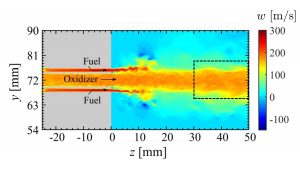From the Journal: Physics of Fluids
WASHINGTON, June 22, 2021 — Combustion engines can develop high frequency oscillations, leading to structural damage to the engines and unsafe operating conditions. A detailed understanding of the physical mechanism that causes these oscillations is required but has been lacking until now.
In Physics of Fluids, by AIP Publishing, research from the Tokyo University of Science and the Japan Aerospace Exploration Agency clarifies the feedback processes that give rise to these oscillations in rocket engines.

Credit: Satomi Shima, Kosuke Nakamura, Hiroshi Gotoda, Yuya Ohmichi, and Shingo Matsuyama
The investigators studied simulated combustion events in a computational model of a rocket combustor. Their analysis involved sophisticated techniques, including symbolic dynamics and the use of complex networks to understand the transition into oscillatory behavior.
The symbolic dynamics techniques allowed the scientists to determine similarities in behavior between two variables that characterize the combustion event. They found a relationship between fluctuations in the flow velocity of the fuel injector and fluctuations in the heat release rate of the combustor.
A rocket engine uses injectors to deliver a fuel, typically hydrogen gas, H2, and an oxidizer, oxygen gas, O2, to a combustion chamber where ignition and subsequent combustion of the fuel occurs.
“Periodic contact of the unburnt H2/O2 mixture with high-temperature products of the H2 and air flame gives rise to significant fluctuations in the ignition location,” said author Hiroshi Gotoda.
Fluctuations in the ignition location produce fluctuations in the heat release rate, which affects pressure fluctuations in the combustor.
“We found that the heat release fluctuations and pressure fluctuations synchronize to each other,” said Gotoda.
The product of the pressure and the heat release rate fluctuations in the combustor is an important physical quantity for understanding the origin of combustion oscillations. Regions where this product is greater than zero correspond to acoustic power sources that drive the oscillations.
The investigators discovered power sources in the shear layer near the injector rim. These power sources would suddenly collapse and reemerge upstream in a periodic fashion, leading to oscillations in combustion.
“The repetition of the formation and collapse of thermoacoustic source clusters in the hydrodynamic shear layer region between the inner oxidizer and outer fuel jets plays an important role in driving combustion oscillations,” said Gotoda.
The investigators believe their analysis method will lead to a better understanding of the dangerous oscillations that sometimes arise in rocket engines and other combustors.
The article “Formation mechanism of high-frequency combustion oscillations in a model rocket engine combustor” is authored by Satomi Shima, Kosuke Nakamura, Hiroshi Gotoda, Yuya Ohmichi, and Shingo Matsuyama. The article will appear in Physics of Fluids on June 22, 2021 (DOI: 10.1063/5.0048785). After that date, it can be accessed at https://aip.scitation.org/doi/full/10.1063/5.0048785.
For more information:
Larry Frum
media@aip.org
301-209-3090
Authors
Satomi Shima, Kosuke Nakamura, Hiroshi Gotoda, Yuya Ohmichi, and Shingo Matsuyama
Author Affiliations
Tokyo University of Science and Japan Aerospace Exploration Agency
